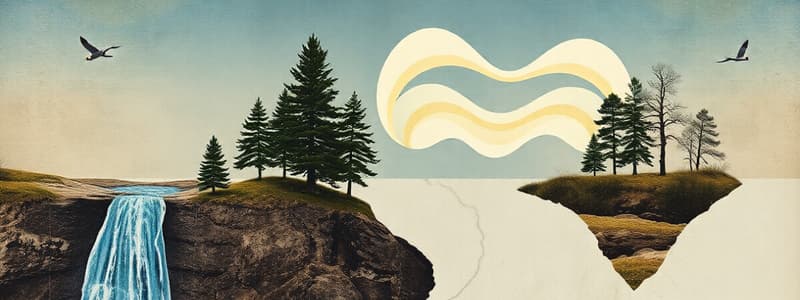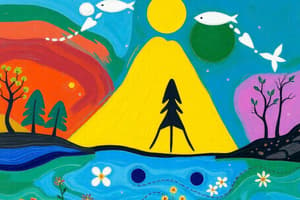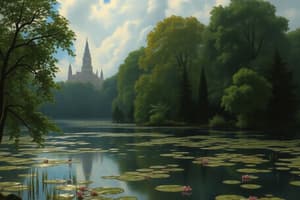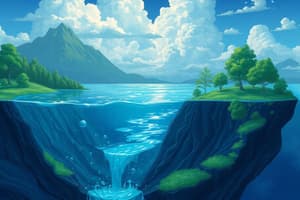Podcast
Questions and Answers
Which of the following processes directly returns water to the atmosphere in the water cycle?
Which of the following processes directly returns water to the atmosphere in the water cycle?
- Surface runoff
- Infiltration into groundwater
- Precipitation
- Evaporation (correct)
What is the primary role of photosynthesis in the carbon cycle?
What is the primary role of photosynthesis in the carbon cycle?
- Releasing carbon dioxide into the atmosphere.
- Consuming other organisms to obtain carbon.
- Converting atmospheric carbon dioxide into carbohydrates. (correct)
- Breaking down organic compounds.
Decomposers play what crucial role in both the carbon and water cycles?
Decomposers play what crucial role in both the carbon and water cycles?
- Returning carbon and nutrients to the environment. (correct)
- Producing oxygen for respiration.
- Facilitating nitrogen fixation.
- Generating fossil fuels.
How do factories, power stations, and vehicle emissions primarily impact the carbon cycle?
How do factories, power stations, and vehicle emissions primarily impact the carbon cycle?
What is the importance of nitrogen fixation in the nitrogen cycle?
What is the importance of nitrogen fixation in the nitrogen cycle?
Which of the following best describes the relationship between photosynthesis and respiration in the carbon cycle?
Which of the following best describes the relationship between photosynthesis and respiration in the carbon cycle?
Which of the following is a direct pathway for carbon to move from a terrestrial ecosystem to an aquatic ecosystem?
Which of the following is a direct pathway for carbon to move from a terrestrial ecosystem to an aquatic ecosystem?
How would a significant increase in deforestation likely affect the carbon cycle?
How would a significant increase in deforestation likely affect the carbon cycle?
Which of these processes plays a key role in linking the water cycle with the carbon cycle?
Which of these processes plays a key role in linking the water cycle with the carbon cycle?
Examine the following scenario: A farmer applies excessive amounts of nitrogen-based fertilizer to a field. How might this primarily affect the nitrogen cycle?
Examine the following scenario: A farmer applies excessive amounts of nitrogen-based fertilizer to a field. How might this primarily affect the nitrogen cycle?
Flashcards
Water Cycle
Water Cycle
The continuous movement of water on, above, and below the surface of the Earth.
Evaporation
Evaporation
Water changing from a liquid to a gas.
Condensation
Condensation
Water vapor changing into liquid water, forming clouds.
Precipitation
Precipitation
Signup and view all the flashcards
Carbon Cycle
Carbon Cycle
Signup and view all the flashcards
Producers
Producers
Signup and view all the flashcards
Consumers
Consumers
Signup and view all the flashcards
Decomposers
Decomposers
Signup and view all the flashcards
Nitrogen Cycle
Nitrogen Cycle
Signup and view all the flashcards
Nitrogen Fixation
Nitrogen Fixation
Signup and view all the flashcards
Study Notes
- The ongoing water cycle involves animals obtaining water through their diets or transpiration.
- Animals lose water through urination, sweating, and breathing.
- Water vapor in the atmosphere condenses into clouds, leading to precipitation like rain or snow.
- Rainwater runoff joins bodies of water or infiltrates underground reservoirs.
- Snow melts into bodies of water.
- Water exists in liquid form for varying periods depending on factors like the season and location.
- It re-enters the atmosphere through evaporation, restarting the cycle.
The Carbon Cycle
- Carbon is a key component of organic chemicals in living organisms, oceans, land, and the atmosphere; it is recycled between living and nonliving things.
- Atmospheric carbon exists mainly as carbon dioxide.
- In terrestrial ecosystems, producers use photosynthesis to convert carbon dioxide and water into carbohydrates.
- Producers release carbon dioxide back into the environment during cellular respiration as they break down carbohydrates.
- When consumers eat plants, they obtain carbon compounds and energy.
- Releasing carbon dioxide and water back into the air occurs through respiration as consumers break down carbon-containing molecules.
- Decomposers break down organic compounds, returning carbon into the environment.
- In aquatic ecosystems, carbon dioxide diffuses between water and air.
- Photosynthetic organisms use dissolved carbon dioxide and release oxygen into the water.
- Marine consumers take in dissolved oxygen and release carbon dioxide into the water.
- Decomposers break down dead aquatic organisms, releasing carbon dioxide back into the ecosystem.
- Another carbon circulation route involves the remains of terrestrial and aquatic organisms becoming buried underground for millions of years and converting into fossil fuels; fossil fuels release carbon dioxide into the atmosphere through combustion.
The Nitrogen Cycle
- Living things use nitrogen to synthesize molecules like proteins and nucleic acids.
- Nitrogen is converted into different chemical forms in ecosystems during this cycle.
- Some nitrogen forms, like nitrates and ammonium, can be directly used by living organisms.
- Gaseous nitrogen is abundant in the atmosphere, but also inaccessible to living things.
- Nitrogen fixation converts atmospheric nitrogen gas into usable nitrogen-containing compounds like nitrates and ammonia.
- Nitrogen fixation can occur through nitrogen-fixing bacteria, lightning, or industrial means.
Studying That Suits You
Use AI to generate personalized quizzes and flashcards to suit your learning preferences.




